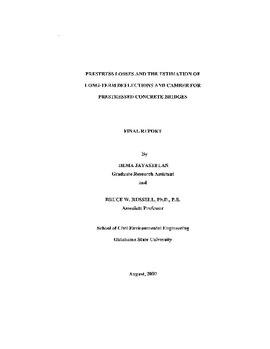| dc.creator | Jayaseelan, Hema | |
| dc.creator | Russell, Bruce W. | |
| dc.date.accessioned | 2018-04-20T22:47:25Z | |
| dc.date.available | 2018-04-20T22:47:25Z | |
| dc.date.issued | 2007-8 | |
| dc.identifier.govdoc | FHWA-OK-07-08 | |
| dc.identifier.other | Oklahoma Department of Transportation State Planning and Research | |
| dc.identifier.uri | https://hdl.handle.net/11244/299494 | |
| dc.description.abstract | Prestressed concrete, an ideal combination of concrete and high strength steel, has emerged as an efficient material for modern construction. The construction of prestressed concrete bridges as a standard practice in the United States dates back to 1949 when the Philadelphia Walnut Ave Bridge was constructed. The technical and economical benefits of prestressed concrete permits longer spans and increased girder spacing. Complimenting this, higher performance concrete can feature lower water to cementious materials ratio (w/cm) and the inclusion of supplemental cementious materials that promote a dramatic improvement of concrete quality and durability. | |
| dc.format.extent | 100 pages | |
| dc.format.extent | 1,852,087 bytes | |
| dc.format.medium | application.pdf | |
| dc.language | en_US | |
| dc.relation.ispartofseries | No | |
| dc.relation.requires | Adobe Acrobat Reader | |
| dc.relation.uri | http://www.okladot.state.ok.us/hqdiv/p-r-div/spr-rip/library/reports/fhwa-ok0708.pdf | |
| dc.title | PRESTRESS LOSSES AND THE ESTIMATION OF LONG-TERM DEFLECTIONS AND CAMBER FOR PRESTRESSED CONCRETE BRIDGES (FHWA-OK-07-08) | |
| dc.type | Technical Report | |
| dc.description.version | Final report | |
| dc.description.peerreview | No | |
| dc.type.material | text | |
| dc.contributor.sponsor | Oklahoma Department of Transportation. Materials and Research Division. Office of Research & Implementation | |
